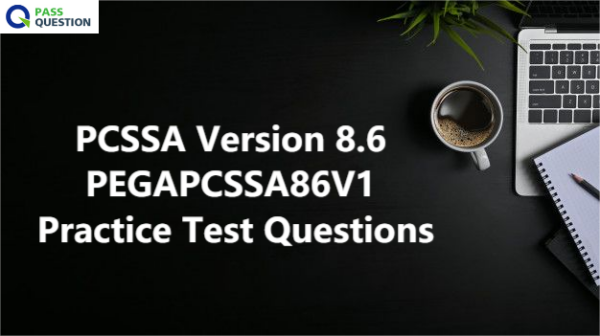PCSSA Version 8.6 PEGAPCSSA86V1 Practice Test Questions
To help you best prepare for PEGAPCSSA86V1 Pega Certified Senior System Architect (PCSSA) 86V1 exam, PassQuestion provides thoroughly PCSSA Version 8.6 PEGAPCSSA86V1 Practice Test Questions which are the best way for clearing Pega Certified Senior System Architect (PCSSA) 86V1 test and to get certified by Pegasystems Pega CSA.The core knowledge of our PCSSA Version 8.6 PEGAPCSSA86V1 Practice Test Questions is compiled based on the latest real questions and similiar with the real test. Also we provide simulation function to help you prepare better. You will feel the real test type and questions style, so that you will feel easy while in the real test after preparing with our PCSSA Version 8.6 PEGAPCSSA86V1 Practice Test Questions.

Pega Certified Senior System Architect (PCSSA) 86V1
The Pega Certified Senior System Architect (PCSSA) certification validates the ability to use Pega to design and build for reusability across multiple lines of business. It includes applying best practices, understanding application debugging and performance tuning, and addressing security/access requirements in an application. The PCSSA version 8.6 exam includes scenario questions, multiple choice questions and drag/drop items. If multiple answers are required, the text states how many responses are needed. Pega Certified System Architect (P/CSA) certification in any version is required to begin the PCSSA certification program.
PCSSA Version 8.6 Exam Information:
Exam Code: PEGAPCSSA86V1
Type of Exam: 60 question exam
Length: 90 minutes
Passing Grade: 70%
Language: English
Exam Objectives
Application Development (17%)
- Define the Enterprise Class Structure
- Create an application with the New Application wizard
- Understand the rule resolution process; Adjust rule availability
- Identify how circumstancing affects application behavior
- Circumstance rules on a single variable or multiple variables
- Differentiate between a queue processor and a job scheduler
- Identify the role and elements of activities in case processing
- Automate actions when a property value changes
- Promote rule reuse with relevant records
- Review Log Files: Distinguish system events and performance events
Case Management (12%)
- Differentiate between work groups, work queues, and organizational structures
- Configure parallel processing for cases
- Manage concurrent case access; Locking strategies
- Configure flow action pre- and post- processing
- Extend service-level agreement configurations
Data and Integration (16%)
- Configure Field Values
- Validate data against a pattern
- Identify use cases for Keyed Data Pages
- Exchange data with other applications
- Manage integration settings
- Address integration errors in connectors
- Expose an application with a web service
- Create and set application variables
User Experience (8%)
- Create and customize Pega Web Mashups
- Configure Pega Web Mashup authentication
Reporting (7%)
- Design reports with multiple sources; associations and joins
Performance (10%)
- Measure System Performance; use of performance-related tools
- Debug system performance
Security (15%)
- Distinguish between role-based and attribute-based access controls
- Identify the role of access control policies in securing an application
- Organize and manage case attachments
- Secure data with client-based access control
Deployments (10%)
- Identify the role and impacts of application versioning; Use of ruleset skimming
- Configure and validate application rulesets
- Branch rulesets for parallel development
- Migrate an application; Use of product rules
Mobility (5%)
- Differentiate between the delivery options for mobile devices
- Design applications for mobile use; use of certificate sets
View Online PCSSA Version 8.6 PEGAPCSSA86V1 Free Questions
Which statement regarding managing encrypted data in Pega Platform is true?
A.Encrypted properties cannot be referenced using filter conditions in reports.
B.Property-level encryption is a time-efficient method to encrypt data.
C.Encrypted properties can be referenced in report definitions.
D.Each organization uses a custom key to encrypt its data.
Answer : A, D
A developer has identified resource-intensive queue processors as the source of performance issues that application users are experiencing.
Which two actions do you perform to resolve the performance issues? (Choose Two)
A.Associate the queue processors with the appropriate node types.
B.Select the Include in background processing option on the application rule.
C.Configure the queue processors to run multiple times a day.
D.Configure the application nodes with node types.
Answer : A, D
Which three options do you consider when deciding to use post-processing actions on a flow action? (Choose Three)
A.The effect if the flow action is reloaded
B.The sequence in which the system runs different actions
C.The timing of the commit for the flow action
D.The security setting for the flow action
E.The potential reuse of the flow action
Answer : A, D
Consider the following requirement: An auditing policy explicitly requires that employees cannot see the contents of complaints made against themselves.
Which security solution do you use to satisfy the requirement?
A.Access of Role to Object
B.Access Control Policy
C.Access When
D.Access Deny
Answer : A
Which two requirements are supported by Attribute-based access control (ABAC)? (Choose Two)
A.Managers can reschedule but not delete appointments.
B.Personal identifying information in the Work-Baking- class is restricted.
C.Agents assigned the 'Top Secret' clearance level can delete reports.
D.Bakers with a rating of 4 or better can add recipes to the database.
Answer : A, B
Which two use cases correctly describe controlling access to an attachment category? (Choose Two)
A.Configure the When condition 'IsCurrentStageTesting' to allow users to view an attachment if the rule returns true.
B.Configure a Visible when condition called 'IsDocumentPrivate' to allow users to view an attachment if the rule returns false.
C.Configure the privilege 'DeleteOwn' and assign it to a user so that a user can delete their own attachments.
D.Configure Client-based access control on the class where the attachment category exists to restrict access to the attachment.
Answer : A, C
Comments
Post a Comment